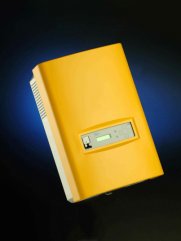 |
Advance:
|  |
| INFORMATION: |
 |

|
|
|
COMPONENTS: |

|
|
When designing a utility backup/interface system it is critical that you size your battery bank properly. Letís say you are tired of roaming blackouts that last two hours. Two hours isnít enough time for your freezer to melt or refrigerator to start making science projects. However, two hours is a long time to be without lights, radio, computer, phones, sump pump in the basement during a rain storm or no cash register for a business. It is very simple to design a system that will only run the loads you need. A qualified electrician can easily "pull" these circuits out of your service entrance and install a "sub" panel that powers these critical loads. This is where your backup/interface system is installed. It can automatically keep these loads on (islanding) while the rest of the house has no power because the utility power is off. You can take this scenario as far as you want. Longer duration of run times need bigger battery banks. More loads mean bigger inverters and bigger battery banks. We have designed and installed thousands of "stand alone" systems that run all the loads all the time.
We have designed and installed the second largest utility interface/backup solar
system tied to the PG&E grid. This system was highlighted in the San
Francisco Chronicle on 11/8/01. Utility interface/backup inverter systems are flexible as to the matching of solar power to inverter power. The inverter size rating (watts) is the maximum the system can feed back into the grid. You can install more of less solar power then the actual inverter power rating. These systems are basically two systems. One system controls solar power to the batteries. The other supplies battery power to the inverter. The solar panel power must be matched with the solar panel input controls. Xantrex uses normal charge controllers. So you could design the input circuit around any charge controller you desire. Go to www.advancepower.net to access different types of batteries for the above systems.
Donít see what you want? Design your own system and e-mail it to us. Weíll give you a quote
.
GRID TIE WITH BACKUP INCENTIVES:
New Residences that include a Utility Grid Tie Interface Systems with Backup are eligible for an incentive of up to $2.50
per watt from the New Solar Homes Partnership as calculated by their NSHP Solar Calculator. Existing Residences and Businesses adding a Grid Tie System under 30kW that includes Backup will use the CSI Calculator which gives the Expected Performance Based Buydown (EPBB) amount. The current maximum rebate for PG&E is $1.10 per Watt for Residential and Commercial Systems.
UTILITY BACKUP SYSTEMS USING
SUNNY ISLAND BY SMA :
This inverter will work in conjunction with utility interface systems, generators, wind machines or any other source
that supplies power when the grid goes down.
Also available in a 5kW version: ($4300.00)
UTILITY INTERFACE/BACKUP SYSTEMS USING XANTREX/OUTBACK INVERTERS:
Xantrex/Outback manufactures complete prewired and assembled power systems (POWER PANELS)
that can be truck freighted right to the job site. These systems supply power when the utility power is down and feed the power into the grid when the power is up to eliminate your electric bill. PLUS, they can accomodate a generator for prolonged power
outages. In generator mode the inverters automatically recharge your battery bank. They can even be programmed to automatically start your generator at a preset low voltage point for a totally automatic and self contained energy system.
If you don't see what you want give us a call or go to
www.xantrex.com or www.outbackpower.com.
XANTREX: SINE WAVE: 4KVA available 24 or 48 vdc input. 5.5KVA
available only in 48vdc. 120 vac output. Two sine wave inverters
(same model) can be stacked for 240 vac output (requires stacking cable).
These inverers are stepped approximation of a true sine wave. Computer
controlled. for more information on these incredible inverter go to
www.xantrex.com.
Xantrex makes complete power panels. Inverters, DC mains, Charge controller
and everything else you need for a complete installation. Power panels are
totally prewired and can be shipped right to the job site.
Utility interface/backup inverter systems are
flexible as to the matching of solar power to inverter power. The inverter
size rating (watts) is the maximum the system can feed back into the grid. You
can install more of less solar power then the actual inverter power rating.
These systems are basically two systems. One system controls solar power
to the batteries. The other supplies battery power to the inverter.
The solar panel power must be matched with the solar panel input controls. Xantrex uses normal charge controllers. So you could design the input circuit around any charge controller you desire.
The CEC allows you to resubmit buydown requests whenever you increase your
system solar power production.
Go to www.advancepower.net
to access different types of batteries for the above systems.
Donít see what you want? Design your own system and e-mail it to us. Weíll give you a quote
.
20 kW EXELTECH STAND ALONE SYSTEM
We have designed and installed many 20Kw inverter systems (Exeltech). These systems range from 20 SR-100 to over 100 SR-100. Battery banks up to 4200 amp hour @ 48vdc. One system alone had six refrigerator & freezers. Dual electric ovens. 240 vac well and pressure booster pumps. Central heating & cooling. The main house is over 6,000 sq. ft.. The three car garage has Grammas apartment above it. Plus this system runs a complete woodworking shop. This client came to us because the winter was so severe and the snow was so high he had to climb out the upstairs window. Power was out for almost a month. This system powers all the loads all the time. If the solar panels and wind machine don't produce enough power we use the grid to power battery chargers. If grid power fails the generator comes on automatically to power the chargers. This system design eliminates phase shifts, sags and surges due to poor grid power.
MULTIPLE INVERTER SYSTEMS
We were the first company to design systems with multiple inverters. Many years ago we set up one of the largest cattle ranches in California with a 6 inverter system. These systems have been in use for years with very minimal problems or maintenance.
3 PHASE VINEYARD IRRIGATION SYSTEM
We designed and installed the first inverter powered 3 phase vineyard irrigation pumping system. Powered by Exeltech and 54
kWh of battery power.
44 kW EXELTECH STAND ALONE SYSTEM
We have just finished the installation of a dual 22 kW Exeltech system for a vineyard in Napa. This system powers 5 irrigation pumps, two well pumps and three air conditioners (one 2.5 ton and two 2 ton). This home also has a swimming pool and every appliance known to man. This system even powers the sensitive loads like Satellite phones, internet connections and computers. It is powered by a 65 kW propane powered generator that runs 3 to 4 hours a day on average. The four battery chargers require 60 kW. This system is supported by 233 kWh of battery storage and supplies, on average, 40 to 50 kWh per day. In the near future we will be installing 75 - 150 watt solar panels.
WORKING TO SOLVE YOUR ENERGY NEEDS SINCE 1978
We have consistently been in the forefront of this industry for over 20 years. Keeping true to our mission we are the first energy company to be able to supply you with fuel cells. This exciting technology is the future of energy production. We are a distributor for major fuel cell manufacturers. 1-888-228-9694 (toll free) or 707-485-0588 or E-mail us |
| TOP | HOME | ORDER |
















